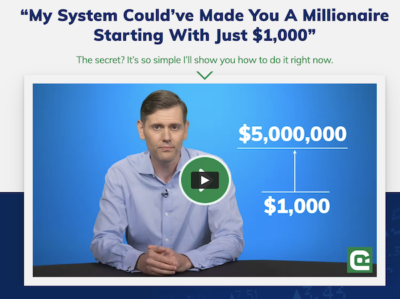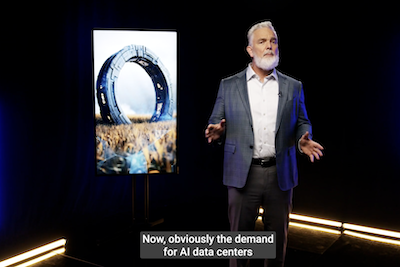I recently stumbled across a presentation by Curzio Research’s Luke Downey, who claims his system “could’ve” helped you turn $1,000 into over $5 million based on backtesting data.
According to Luke Downey, the test was conducted by engineering students at Cornell and essentially ran his “Big Money” system through historical data between 1997 to 2017, which supposedly showed that the system could’ve helped anyone who’d followed the system become a millionaire.
Downey also states that for $97, you can join The Big Money Report and access his latest investment recommendations, which are based on the same system.
Is it legit? Luke Downey made some bold statements about how easy it can be to make money with the system during the presentation, so I was initially skeptical. However, my research suggests that Downey is a real trading expert, and I don’t believe his system is a scam.
That said, there’s no guarantee the system will help you become a millionaire. So I don’t recommend signing up expecting to get rich quickly because that will likely lead to disappointment.
Read on for my complete review.
The Big Money Report Review
To help you make a more informed choice, let’s take a look at what the service is about, how the system works, and what you get if you decide to join.
What is The Big Money Report?
The Big Money Report is an investment advisory service run by Luke Downey of Curzio Research focused on uncovering “fantastic businesses with massive long-term potential.” And as a subscriber of the service, you get Luke Downey’s investment insights and stock picks each month.
According to Downey, his recommendations don’t involve trading options or speculating on “high-risk tech or biotech.” Instead, the Curzio Research website states that the service “follows a strategy that’s made countless millionaires on Wall Street,” which Downey says he learned by following how the “Big Money” (AKA institutional investors) trade the market.
Downey claims he learned this strategy from a Wall Street trader he worked for who, instead of trying to figure out which stocks were going to win, was primarily focused on how much money was pouring into each stock. Because, according to Downey, “Big Money and ONLY Big Money moves stocks.”
So, long story short, Downey’s system is all about following what large Wall Street firms are investing in. He essentially tracks the “big money” that has the potential to move the stock price and aims to take a long-term position with the goal of benefiting from this activity.
One example of a “Big Money” trade Luke Downey shares is Morgan Stanley between late 2020 to around May 2021. During the presentation, he shows a chart of Morgan Stanley trading sideways for several months before it suddenly started going up.
And Downey (more or less) suggests this was related to BlackRock, the world’s largest asset manager, buying 16.9 million shares, which he says they didn’t have to disclose for 90 days.
He provides numerous other examples, but his overall point is that institutional money is what moves the market, and retail investors aren’t aware of what’s going on until after the share price goes up.
However, Downey suggests that his system could help turn that around because it can spot these “Big Money” moves in time to help subscribers potentially profit from them.
How does “Big Money” system work?
According to Luke Downey, he developed his own “screening system” for picking stocks based on what he learned on Wall Street, which is based on the following two principles.
“First piece: Big Money moves stocks.”
“Second piece: Big Money routinely goes after the SAME KINDS of stocks.”
“Using these two principles I developed my own screening system for picking stocks.”
Source: curzioresearch.com
According to Luke Downey, the first part of his system is “designed to spot unusual trading activity,” which he describes as block trades, order flow, and derivative hedging. He also suggests that close to “half of all big trading,” the types of trades he follows, takes place in dark pools.
What’s that? A dark pool is essentially a private exchange where institutional investors can buy and sell shares, and it’s not accessible to the general investing public.
According to Investopedia, they were created to facilitate block trading, a trade where two parties agree to buy or sell a large volume of securities at a set price.
And the reason these trades take place in a dark pool exchange is that it can be more advantageous for large firms, given that large orders tend to move the share price.
So, in other words… dark pools can help institutional investors avoid paying more for a stock they want to buy and get more for shares they want to sell because the share price doesn’t move based on their activity as it could in the public market given the amount of money changing hands.
To be clear, Luke Downey doesn’t claim to have access to dark pool data. However, he does claim to have designed a system that can spot “unusual trading activity” like block trades, which is what dark pools were created to facilitate.
In any case, Downey claims that he’s “not interested in just any stock Big Money might be chasing.” Instead, he says he’s only interested in “the best of the best,” which he defines as companies he can “buy and hold and generate a monster return from.”
Once he identifies a stock with unusual trading activity, Downey says he then combs through the numbers that “matter most to Big Money.” In other words, he looks at the numbers associated with the company that large Wall Street investors are likely interested in.
From there, Luke Downey recommends his top picks with subscribers in the monthly issues of The Big Money Report and says that it’s possible to take a position before “Big Money” is done buying.
“Big Money moves stocks.”
“Using this as my starting point…”
“And filtering what I find through the key fundamental metrics that matter most to Wall Street…”
“You’ll receive a new report from me every month recommending exactly where you should be putting your money next.”
“When we see Big Money moving to a stock, we can often set a position well before the Big Money is even done buying.”
So, to sum it up, Downey claims to have developed a system for spotting “Big Money” trades in the market based on “unusual trading activity,” and he shares his recommendations on how to potentially profit from this with subscribers of The Big Money Report.
What do you get if you join?
The core aspect of The Big Money Report service is the monthly reports which are released on the fourth Tuesday of every month. Each issue covers Luke Downey’s take on current market conditions, where he believes the “big money” is moving, and his latest stock picks.
Each issue is broken down in both video and written format so you can decide which you prefer, and Downey provides updates on his recommendations via email as needed.
Aside from stock picks, subscribers get access to the following resources:
- Welcome To Big Money: Your Guide To Winning Stocks – Getting started guide that walks you through how the system works, what you can expect as a member, and Luke Downey’s investment philosophy.
- Get In And Get Out: The Stocks You Absolutely DO and DON’T Want to Own – Video series that breaks down what he believes are the “absolute best and worst stocks” of the moment. According to Downey, he updates this regularly and right now there are three stocks he recommends buying and three he suggests selling if you already own them.
- Lessons With Luke Starter Package – Video training series covering various investment topics including how to judge stocks, profiting from market dips, and mistakes to avoid.
Cost and refund policy
The Big Money Report costs $97 per year and comes with a 30-day refund policy.
Will You Get Rich With The Big Money Report?
According to Luke Downey’s presentation on the Curzio website, The Big Money Report could’ve made you a millionaire, starting with $1,000.

What does he mean by “could’ve made you a millionaire?”
Well, as the presentation continued, I learned that Downey is basing that statement on a backtest he claims engineers from Cornell ran to from 1990 to 2017.
This means that the system was supposedly run through historical market data to see how it “could have” performed if you’d followed its recommendations over that time period. And based on that data, Downey claims it could’ve turned $1,000 into $5,188,000.
“I had financial engineering students at Cornell back test this system all the way to 1990.”
“This was a few years ago so the data goes from 1990 to 2017.”
“If you had bought the 20 best stocks from each of those weekly lists at the beginning of the year…”
“Then sold them six months later and bought the 20 best again…”
“You would have made over 500,000%.”
“518,887% to be exact.”
“To put that in money terms, if you had dedicated just $1,000 to this strategy – and remember, all you’re doing is buying 20 predetermined stocks twice a year – completely on autopilot…”
“You would be sitting on a nest egg of $5,188,000.”
My interpretation of what Downey is saying is that you could’ve turned $1,000 into $5.18 million over 27 years from 1990 to 2017 using his system.
Assuming that’s correct, that would take some of the hype out of the presentation because 27 years is a long time as an investor. However, that’s still a much higher-than-average gain.
Not to mention, while backtesting data might help validate the effectiveness of a trading system, it’s not the same as putting the system to work in real-time.
And even if the system had developed a strong track record of success based on actual trades recommended to subscribers, that doesn’t guarantee it will continue performing. It might, but my point is there is no guarantee because nobody can predict the future.
So, will The Big Money Report help you make millions of dollars?
Anything is possible, I guess. But I wouldn’t sign up to ANY advisory service expecting to make 518,887% returns (lol) because that doesn’t seem realistic to me.
Who Is Luke Downey?
Luke Downey is an investment and trading expert who claims to have made enough money to retire at age 31. He also says that, during his eight years on Wall Street, he was the head of ETF sales at one major firm and the Senior VP of derivatives at another firm.
Does his story check out? According to Downey’s Investopedia profile, yes. Lucas (Luke) Downey was the head of ETF sales at Cantor Fitzgerald and the SVP of derivatives at Jefferies LLC.
The site also says that he and a partner “began designing quantitative models to look for unusual trading activity,” which further confirms the story he shared in the presentation.
After leaving his job at Jefferies LLC, Investopedia states that Downey co-founded a company called MAPsignals. And according to mapsignals.com, the company is dedicated to finding the types of “big money” opportunities that Luke Downey talks about on the Curzio Research website.
From what I can tell, MAPsignals is the same (or very similar) service to what Luke Downey is selling through Curzio Research, too. However, it’s run under the MAP brand, and there are different membership options ranging from $49 to $249 per month.
Aside from sharing Big Money stock tips, Luke Downey is a contributor to the Investopedia Academy instructor for options and holds a Bachelor of Science from Louisiana State University.
What Is Curzio Research?
Curzio Research is the financial publishing company behind The Big Money Report. The company also publishes another service Luke Downey runs called Big Money Trader and half a dozen other services run by different investment experts, including its flagship service, Curzio Research Advisory.
The founder and CEO of the company is Frank Curzio. And according to curzioresearch.com, Curzio learned how to invest from his father, a portfolio manager named Frank Curzio Sr., and has “developed a world-class track record” of his own over the years.
Aside from running Curzio Research, Frank Curzio heads up four different advisories: Curzio Research Advisory, Curzio Venture Opportunities, Crypto Intelligence, and the Dollar Stock Club.
He also runs Wall Street Unplugged, a popular finance podcast on iTunes, and has been featured on shows including CNBC, Fox Business News, and ABC News. Curzio was also once a contributor to Stansberry Research, a well-known publishing company.
Is Curzio Research a reputable company? I haven’t looked into every service the company publishes, but my research suggests that, yes, Curzio Research is a legitimate company.
Is The Big Money Report Legit?
I don’t believe The Big Money Report is a scam, and there are a few reasons I say this.
First, it’s run by Luke Downey, who appears to be a genuine trading expert. His story seems to check out, and I doubt he’d be contributing to Investopedia unless he was the real deal.
Second, the company behind the service, Curzio Research, is a legitimate Florida-based financial publishing company, and I was unable to find anything suggesting it’s a scam.
Third, the company offers a 30-day money-back guarantee on The Big Money Report service. So, worst case, you could try the service out and if you don’t like it, request a refund.
So, The Big Money Report looks legitimate to me. However, it might pay to take some of the marketing with a grain of salt, especially the part about turning $1,000 into over $5 million. Again, anything is possible, but I don’t think that’s what the average investor should expect.
Bottom Line
Luke Downey’s Big Money Report is a $97 per year advisory service designed to identify what stocks “big money” might be putting money into based on unusual trading activity. And he claims he spots these opportunities using a stock screening system he developed.
Should you join the service?
On the one hand, if you want to learn how large Wall Street firms trade the market, and you like the sound of Downey’s strategy, it could be worth a look. And considering the price of the service and refund policy, I don’t see a huge risk in giving it a go for a month.
On the other hand, as with any investment, there are risks involved, so it is possible you could lose money by following the recommendations. And it’s not a get-rich-quick thing, either. So if you are going to join, I suggest approaching it with realistic expectations and a long-term outlook.
That’s my take, anyway. Have you joined The Big Money Report? And if so, what has been your experience so far? Let us know in the comments below.





Please note: By submitting a comment using the above comment form, you confirm that you agree with the storage and handling of your data by this site as detailed in our Privacy Policy.